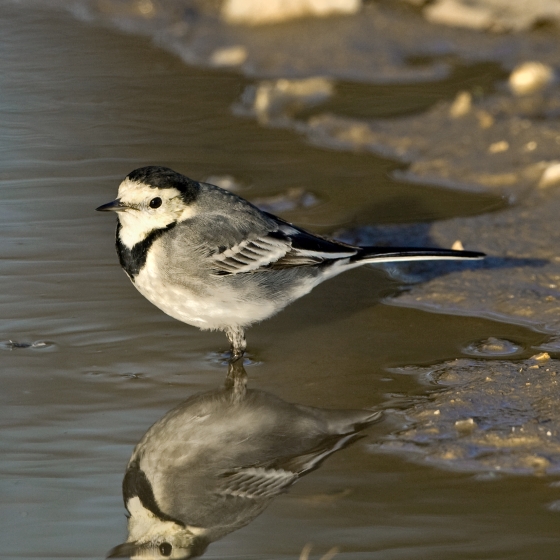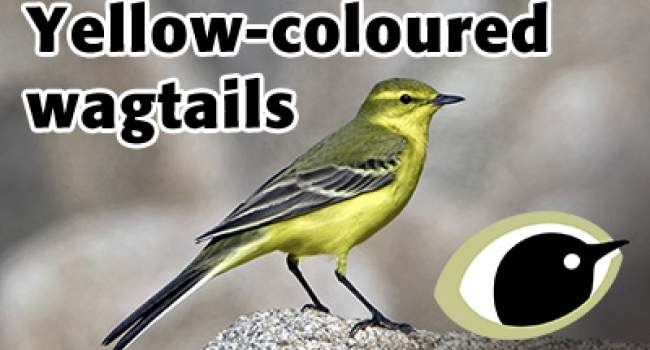Pied/White Wagtail
Motacilla alba (Linnaeus, 1758)
PW
 PIEWA
PIEWA  10200
10200

Family: Passeriformes > Motacillidae

The Pied Wagtail is a familiar bird and the most common wagtail species in Britain & Ireland. Its black, white and grey plumage and bobbing tail are distinctive.
The Pied Wagtail has a grey back and white face with black bib and crown. It is often seen running over the ground pursuing insect prey or 'wagging' its tail rapidly up and down. The species is confiding and frequents urban areas, gathering in large roosts on rooftops and in trees in winter. It has a characteristic "chirrup" call. It is widespread in Britain & Ireland, but is less common on higher ground in winter.
There are two subspecies of Moticilla alba. The subspecies Pied Wagtail (Moticilla alba yarrellii) is found throughout Britain & Ireland and is mostly sedentary, although ringing data show some winter movements into southern Europe. The subspecies White Wagtail (M. alba alba) is found in continental Europe, and is seen as a passage migrant.
Exploring the trends for Pied/White Wagtail
Our Trends Explorer will also give you the latest insight into how the UK's Pied/White Wagtail population is changing.
trends explorerIdentification
Pied/White Wagtail identification is usually straightforward. The following article may help when identifying Pied/White Wagtail.
Identifying yellow-coloured wagtails

When is a yellow wagtail not a Yellow Wagtail? These bright-coloured summer visitors are declining across much of their range and a frequent mistake is believing that any wagtail showing yellow in its plumage is this species.
This video will help you separate individuals from the more widespread resident Grey Wagtail - which despite the name always shows yellow, and even juvenile Pied Wagtails.
Develop your bird ID skills with our training courses
Our interactive online courses are a great way to develop your bird identification skills, whether you're new to the hobby or a competent birder looking to hone your abilities.
Browse training coursesStatus and Trends
Population size and trends and patterns of distribution based on BTO surveys and atlases with data collected by BTO volunteers.
CONSERVATION STATUS
This species can be found on the following statutory and conservation listings and schedules.
POPULATION CHANGE
Britain and Ireland together hold almost the entire world population of the distinctive dark-backed race yarrellii (Pied Wagtail), and for this reason population changes in the UK are of global conservation significance. The CBC shows that a strong increase occurred up to the mid 1970s, such that populations have shown shallow increase overall since 1967. Since 1974, however, the results of monitoring have been somewhat conflicting: CBC/BBS and WBS/WBBS trends fluctuate in parallel but, whereas little overall change is evident in the CBC/BBS index, WBS/WBBS has shown a rapid decline, suggesting a strong influence of factors specific to linear waterways. The BBS map of change in relative density between 1994-96 and 2007-09 indicates that decrease occurred over that period throughout Scotland, away from the western coastal fringe, and in upland and urban areas of England and Wales, and increase mainly in Northern Ireland and westernmost Britain. The European long-term trend, which includes the nominate race of the species (White Wagtail), has been broadly stable since 1980 (PECBMS: PECBMS 2020a>).
| UK breeding population |
+40% increase (1967–2020) 
|
Exploring the trends for Pied/White Wagtail
Our Trends Explorer will also give you the latest insight into how the UK's Pied/White Wagtail population is changing.
trends explorerDISTRIBUTION
Breeding Pied Wagtails are almost ubiquitous in Britain & Ireland, being recorded in 95% of 10-km squares. Upland regions have low densities, although associated river valleys and foothills can support higher numbers. Densities are highest in lowland areas of the north and west but relatively low throughout England, even in grass-dominated areas. Pied Wagtails vacate upland areas of northern Scotland and northern England in winter, and densities are generally low in the northern half of Britain. Densities are high throughout Ireland.
Occupied 10-km squares in UK
| No. occupied in breeding season | 2906 |
| % occupied in breeding season | 96 |
| No. occupied in winter | 2515 |
| % occupied in winter | 83 |
European Distribution Map
European Breeding Bird Atlas 2
Breeding Season Habitats
| Most frequent in |
Villages 
|
| Also common in | Pasture Farmland, Reedbed |
Relative frequency by habitat
Relative occurrence in different habitat types during the breeding season.

DISTRIBUTION CHANGE
Breeding range has changed little and winter range has expanded slightly, mostly around the fringes of the uplands and often involving single birds or early returning breeders.
Change in occupied 10-km squares in the UK
| % change in range in breeding season (1968–72 to 2008–11) | +2.8% |
| % change in range in winter (1981–84 to 2007–11) | +10.4% |
SEASONALITY
Pied Wagtail is widely recorded throughout the year.

Movement
Information about movement and migration based on online bird portals (e.g. BirdTrack), Ringing schemes and tracking studies.
An overview of year-round movements for the whole of Europe can be seen on the EuroBirdPortal viewer.
RINGING RECOVERIES
View a summary of recoveries in the Online Ringing Report.
Foreign locations of birds ringed or recovered in Britain & Ireland

Biology
Lifecycle and body size information about Pied/White Wagtail, including statistics on nesting, eggs and lifespan based on BTO ringing and nest recording data.
PRODUCTIVITY & NESTING
Exploring the trends for Pied/White Wagtail
Our Trends Explorer will also give you the latest insight into how the UK's Pied/White Wagtail population is changing.
trends explorerSURVIVAL & LONGEVITY
View number ringed each year in the Online Ringing Report
Exploring the trends for Pied/White Wagtail
Our Trends Explorer will also give you the latest insight into how the UK's Pied/White Wagtail population is changing.
trends explorerBIOMETRICS
Wing Length 
|
Adults | 89.5±3 | Range 85–94mm, N=6819 |
| Juveniles | 88.7±2.8 | Range 85-93mm, N=7695 | |
| Males | 91.3±2.4 | Range 87–95mm, N=3223 | |
| Females | 87.4±2.2 | Range 84–92mm, N=2640 |
Body Weight 
|
Adults | 22.9±1.89 | Range 20.1–26.1g, N=6044 |
| Juveniles | 22.5±1.8388 | Range 19.6–25.6g, N=6688 | |
| Males | 23.7±1.78 | Range 20.7–26.5g, N=2825 | |
| Females | 22.1±1.62 | Range 19.7–25.0g, N=2348 |
Feather measurements and photos on featherbase 
CODES & CLASSIFICATION
Ring size 
|
A |
Field Codes 
|
2-letter: PW | 5-letter code: PIEWA | Euring: 10200 |
For information in another language (where available) click on a linked name
Research
Interpretation and scientific publications about Pied Wagtail from BTO scientists.
CAUSES AND SOLUTIONS
Causes of change
The causes of change for Pied Wagtail are unclear
Further information on causes of change
The long-term trend in abundance is similar to those shown by Wren and Long-tailed Tit, two other resident insectivores (Siriwardena et al. 1998a). Modelling suggests that climate change may have had a positive impact on the long-term trend for this species (Pearce-Higgins & Crick 2019). Average clutch and brood sizes have declined a little, but this has been counteracted by a large fall in nest failure rates. The number of fledglings per breeding attempt has shown a strong linear increase.
Information about conservation actions
There are currently no conservation concerns about the Pied Wagtail, and whilst numbers have fluctuated, the causes of change are unclear and hence no specific conservation actions have been proposed.
Links to more information from ConservationEvidence.com
Would you like to search for another species?












Share this page